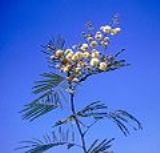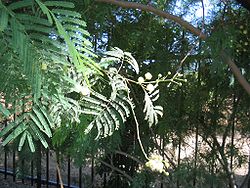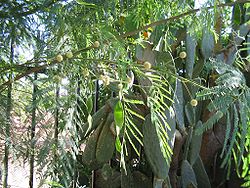
Acacia berlandieri
Encyclopedia
Acacia berlandieri is a shrub
native to the Southwestern United States
and northeast Mexico
that belongs to the subfamily Mimosoideae
(wattles) of Fabaceae
(legumes). It grows 1 to 5 m (3.3 to 16.4 ft) tall, with blossom
s that are spherical and white, occurring from February through April. The berlandieri epithet comes from the name of Jean-Louis Berlandier
, a French
naturalist
who studied wildlife
native to Texas
and Mexico
. A. berlandieri contains a wide variety of alkaloid
s and has been known to cause toxic
reactions in domestic animals such as goats.





and thus should not be used as forage
or fodder
.
s, the most plentiful of which are N-methylphenethylamine, tyramine
, and phenethylamine
. In a recent study, researchers identified thirty-one alkaloids in samples of plant foliage, including trace amounts of five amphetamine
s previously believed to be human inventions: amphetamine, methamphetamine
, N,N-dimethylamphetamine, p-hydroxyamphetamine and p-methoxyamphetamine. Other trace alkaloids include DMT
(found in many related species), nicotine
, and mescaline
(found in many cacti
but infrequently in other plants). The same group of researchers later reported finding most of the same alkaloids in A. rigidula
, a related species also native to the Southwestern U.S. The findings, however, have never been confirmed or repeated, leading some researchers to believe the results were the result of cross-contamination.
Shrub
A shrub or bush is distinguished from a tree by its multiple stems and shorter height, usually under 5–6 m tall. A large number of plants may become either shrubs or trees, depending on the growing conditions they experience...
native to the Southwestern United States
Southwestern United States
The Southwestern United States is a region defined in different ways by different sources. Broad definitions include nearly a quarter of the United States, including Arizona, California, Colorado, Nevada, New Mexico, Oklahoma, Texas and Utah...
and northeast Mexico
Mexico
The United Mexican States , commonly known as Mexico , is a federal constitutional republic in North America. It is bordered on the north by the United States; on the south and west by the Pacific Ocean; on the southeast by Guatemala, Belize, and the Caribbean Sea; and on the east by the Gulf of...
that belongs to the subfamily Mimosoideae
Mimosoideae
Mimosoideae is a subfamily of the flowering plant family Fabaceae characterized by flowers with small petals and numerous prominent stamens...
(wattles) of Fabaceae
Fabaceae
The Fabaceae or Leguminosae, commonly known as the legume, pea, or bean family, is a large and economically important family of flowering plants. The group is the third largest land plant family, behind only the Orchidaceae and Asteraceae, with 730 genera and over 19,400 species...
(legumes). It grows 1 to 5 m (3.3 to 16.4 ft) tall, with blossom
Blossom
In botany, blossom is a term given to the flowers of stone fruit trees and of some other plants with a similar appearance that flower profusely for a period of time in spring...
s that are spherical and white, occurring from February through April. The berlandieri epithet comes from the name of Jean-Louis Berlandier
Jean-Louis Berlandier
Jean-Louis Berlandier was a French naturalist, physician, and anthropologist.Berlandier was born in rural Fort de l'Écluse, near France's border with Switzerland, and trained as a botanist in Geneva...
, a French
France
The French Republic , The French Republic , The French Republic , (commonly known as France , is a unitary semi-presidential republic in Western Europe with several overseas territories and islands located on other continents and in the Indian, Pacific, and Atlantic oceans. Metropolitan France...
naturalist
Natural history
Natural history is the scientific research of plants or animals, leaning more towards observational rather than experimental methods of study, and encompasses more research published in magazines than in academic journals. Grouped among the natural sciences, natural history is the systematic study...
who studied wildlife
Wildlife
Wildlife includes all non-domesticated plants, animals and other organisms. Domesticating wild plant and animal species for human benefit has occurred many times all over the planet, and has a major impact on the environment, both positive and negative....
native to Texas
Texas
Texas is the second largest U.S. state by both area and population, and the largest state by area in the contiguous United States.The name, based on the Caddo word "Tejas" meaning "friends" or "allies", was applied by the Spanish to the Caddo themselves and to the region of their settlement in...
and Mexico
Mexico
The United Mexican States , commonly known as Mexico , is a federal constitutional republic in North America. It is bordered on the north by the United States; on the south and west by the Pacific Ocean; on the southeast by Guatemala, Belize, and the Caribbean Sea; and on the east by the Gulf of...
. A. berlandieri contains a wide variety of alkaloid
Alkaloid
Alkaloids are a group of naturally occurring chemical compounds that contain mostly basic nitrogen atoms. This group also includes some related compounds with neutral and even weakly acidic properties. Also some synthetic compounds of similar structure are attributed to alkaloids...
s and has been known to cause toxic
Toxin
A toxin is a poisonous substance produced within living cells or organisms; man-made substances created by artificial processes are thus excluded...
reactions in domestic animals such as goats.





Uses
A. berlandieri is toxic to livestockLivestock
Livestock refers to one or more domesticated animals raised in an agricultural setting to produce commodities such as food, fiber and labor. The term "livestock" as used in this article does not include poultry or farmed fish; however the inclusion of these, especially poultry, within the meaning...
and thus should not be used as forage
Forage
Forage is plant material eaten by grazing livestock.Historically the term forage has meant only plants eaten by the animals directly as pasture, crop residue, or immature cereal crops, but it is also used more loosely to include similar plants cut for fodder and carried to the animals, especially...
or fodder
Fodder
Fodder or animal feed is any agricultural foodstuff used specifically to feed domesticated livestock such as cattle, goats, sheep, horses, chickens and pigs. Most animal feed is from plants but some is of animal origin...
.
Alkaloids
A. berlandieri contains a number of diverse alkaloidAlkaloid
Alkaloids are a group of naturally occurring chemical compounds that contain mostly basic nitrogen atoms. This group also includes some related compounds with neutral and even weakly acidic properties. Also some synthetic compounds of similar structure are attributed to alkaloids...
s, the most plentiful of which are N-methylphenethylamine, tyramine
Tyramine
Tyramine is a naturally occurring monoamine compound and trace amine derived from the amino acid tyrosine. Tyramine acts as a catecholamine releasing agent...
, and phenethylamine
Phenethylamine
Phenylethylamine or phenethylamine is a natural monoamine alkaloid, trace amine, and also the name of a class of chemicals with many members well known for psychoactive drug and stimulant effects. Studies suggest that phenylethylamine functions as a neuromodulator or neurotransmitter in the...
. In a recent study, researchers identified thirty-one alkaloids in samples of plant foliage, including trace amounts of five amphetamine
Amphetamine
Amphetamine or amfetamine is a psychostimulant drug of the phenethylamine class which produces increased wakefulness and focus in association with decreased fatigue and appetite.Brand names of medications that contain, or metabolize into, amphetamine include Adderall, Dexedrine, Dextrostat,...
s previously believed to be human inventions: amphetamine, methamphetamine
Methamphetamine
Methamphetamine is a psychostimulant of the phenethylamine and amphetamine class of psychoactive drugs...
, N,N-dimethylamphetamine, p-hydroxyamphetamine and p-methoxyamphetamine. Other trace alkaloids include DMT
Dimethyltryptamine
N,N-Dimethyltryptamine is a naturally occurring psychedelic compound of the tryptamine family. DMT is found in several plants, and also in trace amounts in humans and other mammals, where it is originally derived from the essential amino acid tryptophan, and ultimately produced by the enzyme INMT...
(found in many related species), nicotine
Nicotine
Nicotine is an alkaloid found in the nightshade family of plants that constitutes approximately 0.6–3.0% of the dry weight of tobacco, with biosynthesis taking place in the roots and accumulation occurring in the leaves...
, and mescaline
Mescaline
Mescaline or 3,4,5-trimethoxyphenethylamine is a naturally occurring psychedelic alkaloid of the phenethylamine class used mainly as an entheogen....
(found in many cacti
Cactus
A cactus is a member of the plant family Cactaceae. Their distinctive appearance is a result of adaptations to conserve water in dry and/or hot environments. In most species, the stem has evolved to become photosynthetic and succulent, while the leaves have evolved into spines...
but infrequently in other plants). The same group of researchers later reported finding most of the same alkaloids in A. rigidula
Acacia rigidula
Acacia rigidula, commonly known as Blackbrush Acacia or Chaparro Prieto, is a species of shrub or small tree in the legume family, Fabaceae. Its native range stretches from Texas in the United States south to central Mexico. This perennial is closely related to A. berlandieri and is not listed as...
, a related species also native to the Southwestern U.S. The findings, however, have never been confirmed or repeated, leading some researchers to believe the results were the result of cross-contamination.
Some chemical compounds found in Acacia berlandieri
Total alkaloids in dried leaves 0.28-0.66%.- Beta-methyl-phenethylamineBeta-methyl-phenethylamineβ-Methylphenethylamine is a stimulant drug of the phenethylamine chemical class that is related to amphetamine . It is found in Acacia species i.e. Acacia rigidula, Acacia greggii, Acacia schaffneri and notably Acacia berlandieri . The latter produces a paralytic condition in livestock....
- CatechinCatechinCatechin is a natural phenol antioxidant plant secondary metabolite. The term catechins is also commonly used to refer to the related family of flavonoids and the subgroup flavan-3-ols ....
- FisetinFisetinFisetin is a flavonol, a structurally distinct chemical substance that belongs to the flavonoid group of polyphenols. It can be found in many plants, where it serves as a colouring agent...
- HordenineHordenineHordenine is a phenethylamine alkaloid with antibacterial and antibiotic properties. It stimulates the release of norepinephrine in mammals, working as a stimulant...
- PhenethylaminePhenethylaminePhenylethylamine or phenethylamine is a natural monoamine alkaloid, trace amine, and also the name of a class of chemicals with many members well known for psychoactive drug and stimulant effects. Studies suggest that phenylethylamine functions as a neuromodulator or neurotransmitter in the...
- QuercetinQuercetinQuercetin , a flavonol, is a plant-derived flavonoid found in fruits, vegetables, leaves and grains. It also may be used as an ingredient in supplements, beverages or foods.-Occurrence:...
- TyramineTyramineTyramine is a naturally occurring monoamine compound and trace amine derived from the amino acid tyrosine. Tyramine acts as a catecholamine releasing agent...
- TryptamineTryptamineTryptamine is a monoamine alkaloid found in plants, fungi, and animals. It is based around the indole ring structure, and is chemically related to the amino acid tryptophan, from which its name is derived...
90-124 ppb in spring, 287-334 ppb in fall - DimethyltryptamineDimethyltryptamineN,N-Dimethyltryptamine is a naturally occurring psychedelic compound of the tryptamine family. DMT is found in several plants, and also in trace amounts in humans and other mammals, where it is originally derived from the essential amino acid tryptophan, and ultimately produced by the enzyme INMT...
fall only, 75-114 ppb

